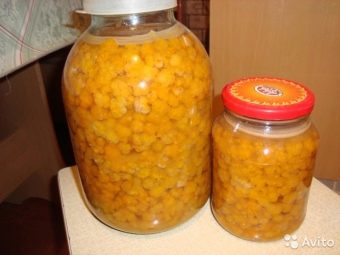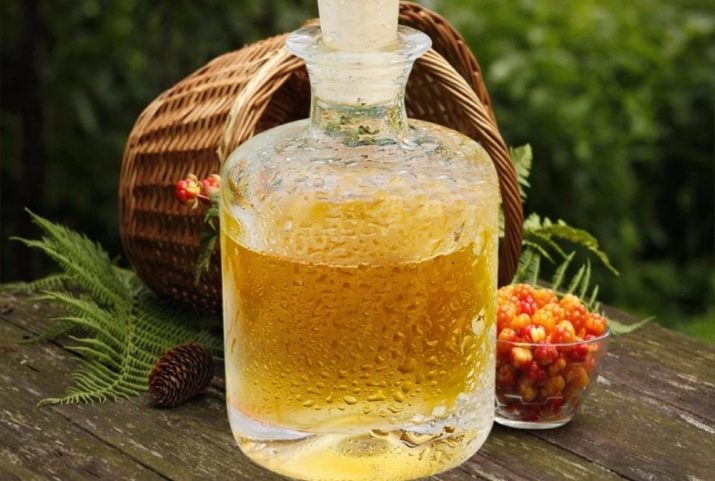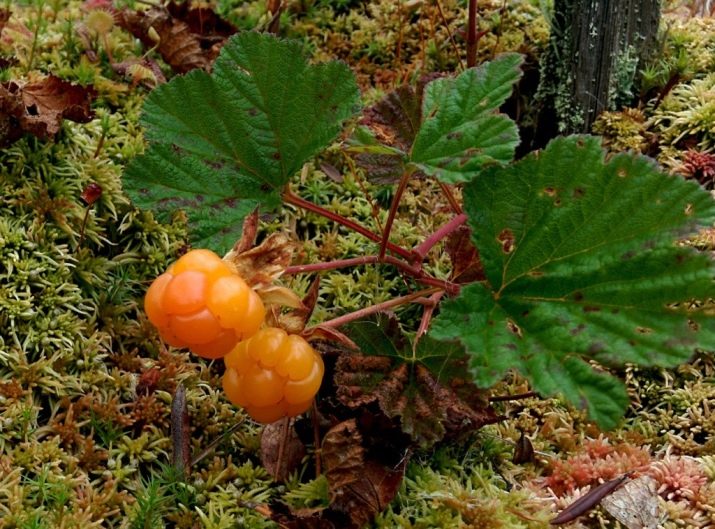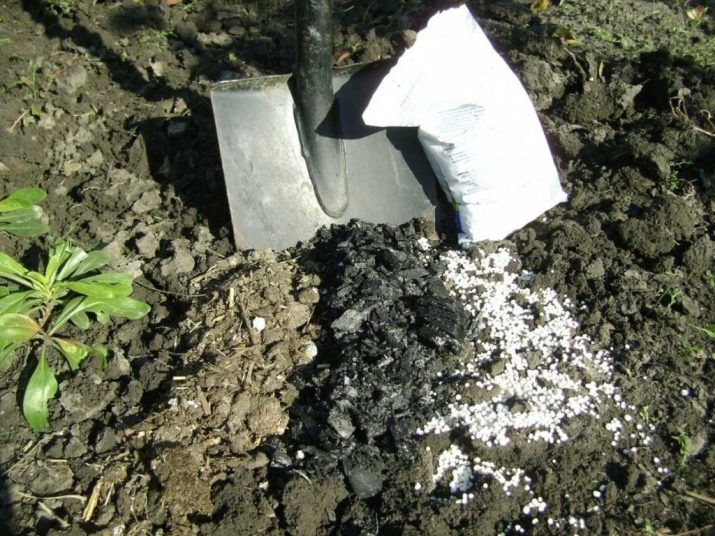Cloudberry: features, cultivation and application
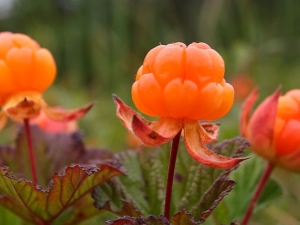
The amber berry with the interesting name cloudberry for many years remains a big mystery to the majority of our compatriots. However, in the northern regions, this tundra berry has been enjoying great popularity and love of the locals for more than one century. Her healing properties were well known in the days of Tsarist Russia. By the way, this fruit is one of the most important tourist attractions of the Scandinavian countries.
What it is?
Cloudberry is a creeping perennial plant that grows in the tundra and forest tundra of the northern hemisphere. The territory of its growth reaches the middle latitudes of Russia, as well as Belarusian and Polish lands.
Many breeders call these fruits a “berry in reverse” - it looks so unusual. Unripe fruits are distinguished by a bright red tint, and as they mature, they brighten and become yellowish-reddish at the ripeness stage, resembling a translucent stone - amber.
The berry grows in a solid carpet of low-growing bushes not exceeding 30 cm. The plant lives in wetlands, in the neighborhood it is often possible to find blueberries, lingonberries and other well-known northern fruit crops.
Cloudberry belongs to the Rosaceae family, the genus Malin. The rhizome ramified in the ground is quite strong and creeping, each year young squat shoots depart 15-20 cm tall, each has 2-3 leaves, and a small flower crowns the very top.
The leaves consist of 5-7 rounded lobes, slightly shriveled, white petals. Cloudberries bloom in June, same-sex flowers, while the male is much larger than the female. The crop matures in 7-9 weeks, the fruits are the drupes.
Berry is sweet and sour, has a tart taste, which many compare with unripe raspberries. The fruits are quite tender and do not tolerate transportation, it cannot be stored for a long time, so most often for commercial purposes it is harvested slightly unripe in the last decade of July - early August, when all other berries are already moving away. Cloudberries are distinguished by high yields - from one hectare of land you can get up to 1 ton of fruit.
By the way, cloudberry roots are commonly used in medicine, so they are also harvested, but later - in November.
Where is growing?
Cloudberries' homeland is the northern natural zone, but it can often be found in the warmer regions of our country. The habitat of this amber raspberry is quite wide: most often it can be found in Komi, as well as in the Krasnoyarsk Territory. Many plants are located in Tomsk, Tyumen, Murmansk and Arkhangelsk regions. In addition, amber fruits are collected in the Leningrad, Novgorod and Pskov regions.
Quite a widespread culture in the near and far abroad - Belarus, Finland and Canada. By the way, the last countries are recognized by world leaders in the harvesting of the tsar’s berries, and in Finland the image of the Arctic raspberry is even transferred to national coins of 2 euro.
Beneficial features
Like all wild berries, these amber fruits can be called a real storehouse of vitamins: it contains a very large amount of vitamins B, E, C and A, and in addition, all parts of the plant are rich in useful mineral elements: potassium, copper and iron, fructose, glucose and organic acids. Moreover, the concentration of these substances is very high, for example, vitamin C in fruits is 4 times more than in orange, and 3 times more than in carrots.
In the northern territories with a harsh climate, berries are quite popular as the strongest immunostimulant and a real salvation from spring scurvy. On harsh winter days, fruits are used to treat colds, sore throats, severe fever, as well as more delicate problems such as cystitis and diseases of the genitourinary system.
Regardless of whether cloudberries are used in raw or processed form, it is an exceptionally strong multivitamin complex for the winter period and boosts immunity, and also allows the body to recover from flu and other serious illnesses as quickly as possible and without consequences.
The fruits of the arctic raspberry and decoctions from its leaves alleviate the condition in atherosclerosis, since the plant is saturated with calcium, which normalizes the mental and physical condition of the sick person. In addition, the presence of this trace element helps to normalize the work of the intestines and liver, helps to remove toxins and toxins from the body, and also eliminates salts, which are a common cause of edema.
Calcium promotes blood clotting and is a good prevention of allergic reactions.
Cloudberries are rich in omega-3 and omega-6 fatty acids, which help maintain cholesterol at a safe level, and in addition, these acids significantly reduce the load on blood vessels and heart muscle.
The Arctic raspberry contains iron, which is a major component in the treatment of anemia, coronary disease and poor blood circulation. Phosphorus prevents the development of osteoporosis and strengthens bones, and magnesium normalizes the activity of nerve tissues.
In the green parts of the plant contains cobalt, which contributes to the improvement of the digestive tract, so the decoction of the sepal is recommended to use in chronic gastritis and diarrhea. It is extremely useful for the organs of the gastrointestinal tract aluminum, which reduces pain in diseases of the pancreas.
The sodium stored in the berry prevents dehydration of all body systems, maintaining an adequate supply of water in the cells and tissues. Silicon has a positive effect on the brain, and it also prevents the development of lung diseases, including tuberculosis.
Vitamin A, present in large quantities in the fruit, prevents the occurrence of cataracts and improves visual acuity. This substance is necessary for skin regeneration in case of injuries and for the restoration of mucous membranes.
B vitamins improve the functioning of the nervous system, and also have a positive effect on the functionality of the vascular walls, improve muscle function, and vitamin E inhibits the process of age-related changes and contributes to the normal production of hormones in the adrenal glands and pituitary gland.
Continuing the description of the beneficial properties of cloudberries, we can say that it is considered to be a truly female berry, as it has a good cosmetic effect. It is no secret that extracts from arctic raspberries are part of nourishing creams and face masks, as well as being a component of hair care products. Using cloudberries create anti-aging remedies that help reduce wrinkles and improve complexion.
However, this is not the only thing that makes these berries useful for women. Cloudberries are highly recommended for women who are expecting a baby - doctors advise you to include it in your diet at least twice a week, because it is saturated with malic and salicylic acids, which the future mother and her baby need so much.
Berry contains a high concentration of tocopherol, which contributes to the proper development of the child in the womb and facilitates the general well-being of a pregnant woman. In addition, cloudberries are used to treat colds in cases where the use of any drugs can be dangerous.
Cloudberry is also needed by children - it is recommended to include it in the children's menu from the year in the form of weakly concentrated compotes and jelly. Berries have a slight antiparasitic effect, so they are often prescribed to rid children of helminthic invasions.
For those who want to lose weight, cloudberry can also be extremely useful.Berry is ideal for inclusion in diets, because it consists of water and vitamins, its caloric content is minimal - 100 g of the product contains only 40 kilocalories, it exhibits an effective diuretic effect and optimizes the lymphatic drainage system.
Contraindications
Like any other products with a high concentration of vitamins, macro-and micronutrients, cloudberries have a number of restrictions in use. Thus, people with any type of allergy to the components of the Arctic raspberry should refrain from consuming the royal berries, since their presence can cause severe itching or rash.
People with increased secretion of the stomach, as well as with peptic ulcers, erosive gastritis in the acute stage should also not eat cloudberries.
Stones in the ureters, kidneys and gall bladder are also a contraindication to the inclusion of berries in the diet.
Eating raw fruit is not allowed for children under 2 years old. Starting from 12 months, it should be introduced into the diet, but only as a part of fruit puree, compotes and decoctions.
Where is it used?
Cloudberry is widely used in traditional medicine. It has received the greatest application in the treatment of cough and other catarrhal diseases - this is done using a decoction of berries and green leaves.
For the preparation of therapeutic broth 1 tbsp. l Amber berries and leaves pour 1 liter of boiling water and allow to infuse. The drug is taken 3-4 times a day until the final disposal of unpleasant manifestations of the disease.
To strengthen the immunity and tonic effect, cloudberries are combined with wild rose berries. For this, the prepared mixture of berries is poured with boiling water in the proportion of 2 tbsp. l spoons per 1 liter, insist to cool completely and drink 100 ml twice a day. The same composition has a healing effect for problems with the heart and blood vessels.
A decoction of the fruits, roots and leaves of the plant is used for cystitis. To get rid of this disease, 1 tbsp. l cloudberries are poured with a liter of liquid and boiled over low heat for 4-5 minutes, then they are wrapped and left to infuse. For the emergence of a pronounced therapeutic effect is recommended to use a decoction of a quarter cup 2-3 times a day.
When preparing infusions, compotes and decoctions of cloudberries, keep in mind that their shelf life is minimal - after 4-5 hours they begin to deteriorate and can cause harm to the body.
As already mentioned, cloudberries are a common component of cosmetics, and for their preparation they use both berry extract and bone extract. Cloudberry helps to reduce irritation of dry skin, removes the feeling of tightness, due to the presence of fatty acids, restores the protective function of the skin, reduces the severity of wrinkles, and the skin after applying such tools acquires an elastic, elastic look.
Cloudberry seed oil is very much appreciated - cosmetologists consider it one of the most effective anti-aging remedies, in the parameters of which the protective and nutritional characteristics are most pronounced. It is used for skin and hair care as a highly concentrated additive for intense exposure. This drug is not used in pure form, moreover, even in combination with other oils limit its content to 10%. However, even at these concentrations, the substance exhibits its highest efficacy.
Leaves and sepals of the Arctic raspberry are also used for medical purposes. They have proven to be quite effective in getting rid of edema, as well as gout and problems with metabolism. In combination with fish oil, cloudberry leaves are used to relieve inflammation in ulcerative purulent wounds.
Consumption tips
The fruits are consumed fresh, as well as in the composition of mashed potatoes, compotes and jelly, good taste is different cloudberry mors and tea. It is used in frozen and dried form and is often added to sweet culinary dishes.
For example, residents of the northern regions like to take berries for making cheesecakes and sweet cakes. This berry is very tasty in the pickled and stewed form. If you grind it with other northern berries - lingonberries or cranberries, you can cook delicious sauces for meat dishes or nutritious jelly.
In Sweden, cloudberries are more commonly consumed as sweet jam. Residents of this country believe that it is fresh too tart, but digested with sugar is the optimal combination of acid and sweetness. Swedes quite often combine cloudberries with cheese or toast with mushrooms - it adds spice to these spicy dishes.
In Finland, Lakka liqueur is produced from Arctic raspberries, which is in demand among lovers of sweet alcoholic beverages all over the world. By the way, this liqueur is often used to make desserts. In addition, cloudberries included in the recipe of most national dishes - it is eaten with melted cheese, added to cakes and jelly with milk or cream.
Residents of foggy Albion are more in the mood for cloudberry jam. This tender berry is very much appreciated in Norway, where it is often added to ice cream and even made from beer.
In Alaska, the royal berry is mixed with deer fat and baked with it rich pies - this dish is very popular among the indigenous people of these areas.
Let us dwell on the most popular recipes from arctic raspberries.
The most famous and simple should be called jam, for it the berry is mixed with sugar in a ratio of 1 to 1, allowed to brew for 24 hours and then boiled over low heat, stirring constantly with a wooden spatula until the mass thickens. With this method of processing, the berry does not lose vitamins and healing substances, therefore, jam can not only please the lovers of sweets, but also help in the fight against winter colds.
Cloudberries are commonly used as part of decoctions, juices and infusions. Cloudberry juice is cooked very simply - the berry is passed through a juicer, pasteurized and rolled into glass jars. The drink can be made with the addition of sugar - for this, 0.5 kg of sugar is added to a liter of the finished juice, stirred and preserved for the winter.
Arctic raspberry jelly is considered a wholesome and sweet dish. To prepare it, grind the berries with a pestle, add water and over low heat and boil for 3-4 minutes, then add gelatin and sugar (at the rate of 500 g per 1 kg of fruit), boil again and boil for 25-30 minutes .
A very beneficial effect on the body has moistened cloudberries. It is prepared in wooden tubs of ripe berries. The recipe is quite simple: put the peeled fruits into a barrel, pour over cooled boiled water, some may add some sugar syrup if desired. Wrap up, put the lid with the load and send in a cool place, for example, the cellar. Berry will be ready to eat in 3-4 days.
How to plant?
Many seek to grow this extraordinary culture in the country or in their own garden. Cloudberries use several methods for propagation. Consider each of them in more detail.
Digging up a bush
To do this, a small shrub is found in the forest and very carefully dig it along with the earthy clod along the periphery so that the height of the rhizome is at least half a meter. It is best to choose areas in which sedge and cotton grass does not grow, since their powerful roots make digging much more difficult. Cloudberry roots are under dense sphagnum at a depth of about 25-35 cm.
The excavated material must not be dried. It should be wrapped in moss, moistened and placed in polyethylene. If neither one nor the other, then you should wrap the roots with paper and periodically moisten it during transportation of the seedling.
Cuttings
In the forest, a large plant is found and small stalks are cut, and then rooted in the greenhouse.They are planted in soil enriched with nutrients, then covered with a film or a cut part of a plastic bottle and watered abundantly. Optimally treat them with solutions that stimulate rooting. In no case should not allow the land to dry out and reduce the level of humidity in the greenhouse.
Seed propagation
When using this method, you should be prepared for the fact that you can wait for the harvest only after a few years, and besides, the plant can differ significantly from the parent, and for the worse.
If the seed material is purchased in limited quantities, then boxes filled with peat and sand in the ratio of 4 to 1 should be used for planting seeds immediately after purchase, because during long-term storage of material its viability is significantly reduced and there is a risk that they simply won't germinate.
After planting the boxes should be placed in the cellar or any other room in which the temperature is maintained at 3-5 degrees, and leave for 1.5 months. After the specified time, the boxes are returned to a warm environment, where they must wait until conditions are optimal for transplanting into open ground.
Seedlings
The modern market offers, as a rule, seedlings of imported varieties that are not able to withstand the protracted Russian winters, so it is optimal to find nurseries that offer plants adapted to our conditions.
Regardless of the breeding method, the land should be properly prepared for planting cloudberries. The soil should be well hydrated, pH - slightly acidic. The site should be well lit and ventilated. It is advisable to disinfect the soil before planting, and then fertilize the ground with a special fungus - mycorrhiza, which is very useful for cloudberries and lives in all places of its natural growth. In the course of its vital activity, this fungus secrete substances that promote the growth and development of the plant.
You can buy a microorganism in a specialty store or get it yourself from the soil.
Land for planting should be a “layer cake” of plastic film and soil. To do this, dig a trench in the ground about 50 cm deep and of the same width. Polyethylene is laid on the bottom of the prepared trench, forming small holes throughout its area, and then it is covered with prepared soil. After that, another layer of film is laid and re-covered with soil.
Keep in mind that in order for the plant to develop well, you should create conditions on the site that are as close to natural as possible. Optimally, if the land will be brought from the swampy areas, where cloudberries grow. Nearby it is worth planting wild rosemary bushes, lingonberries and blueberries will be good neighbors.
Care
The cultivation of plants on an industrial scale began around the 60s of the last century. For the first time, breeders in Norway and Finland did this. In Russia, gardeners and gardeners just now began to develop the Arctic raspberries.
Care for cloudberries, as evidenced by reviews, has its own specifics, and first of all, special attention should be paid to watering. The natural environment in which this amber berry grows implies a high acidic soil, therefore, it is impossible to use chlorinated tap water for watering the plant. Otherwise, there is a high probability of developing chlorosis, which occurs as a result of an increased level of alkali in the ground.
The water used to moisten the soil should be slightly acidified - for this purpose, vinegar or citric acid is added to it at the rate of 2 g per bucket of liquid.
Watering should be abundant, as cloudberries love swamplands. Drying of the soil is not allowed, otherwise you will not get a good harvest. Water should be irrigated daily. On 1 square. m plot should account for at least 50-80 liters of water.If there is no possibility to provide daily watering, then it is necessary to mulch the area near the bush in order to maintain the required level of soil moisture.
Additionally, you can acidify the soil - for this, ground sulfur is added to it. The first 3 years cloudberry needs regular weeding. After the plant is fully formed, no weeds are not afraid of him.
The plant requires regular pruning, its solely sanitary goal is to remove dead and old branches. These works are carried out in early spring before the buds appear. Cloudberries do not need forming.
Like any other crop, cloudberry responds well to fertilization. At the very beginning of spring, it is desirable to fertilize the earth with mineral preparations, and shortly before fruiting, dung should be introduced, as well as special growth stimulants. This feeding is carried out in May.
When growing cloudberries, you can encounter a variety of crop pests - raspberry and spider mites, aphids, stem fly and strawberry weevil. When the first signs of damage appear, the shrub should be treated with insecticide formulations. Gardeners recommend using Karbofos, colloidal sulfur, Metaphos or Actellic.
As a preventive measure can be recommended treatment with a solution of Bordeaux mixture.
Arctic raspberry is used in many areas. It is widely used in folk medicine, as well as cosmetology and cooking. From amber fruits prepare jam, jelly, compotes. It is dried and frozen in order to provide the body with necessary vitamins in winter. She was valued at all times, in connection with which she received the name "Tsar's Berry" among the people.
Interesting facts about drizzle and its application, see the following video.













